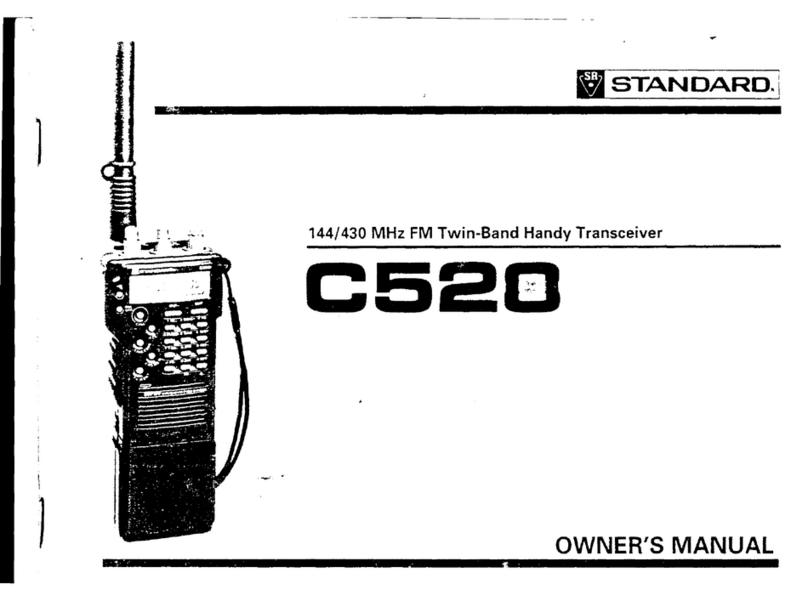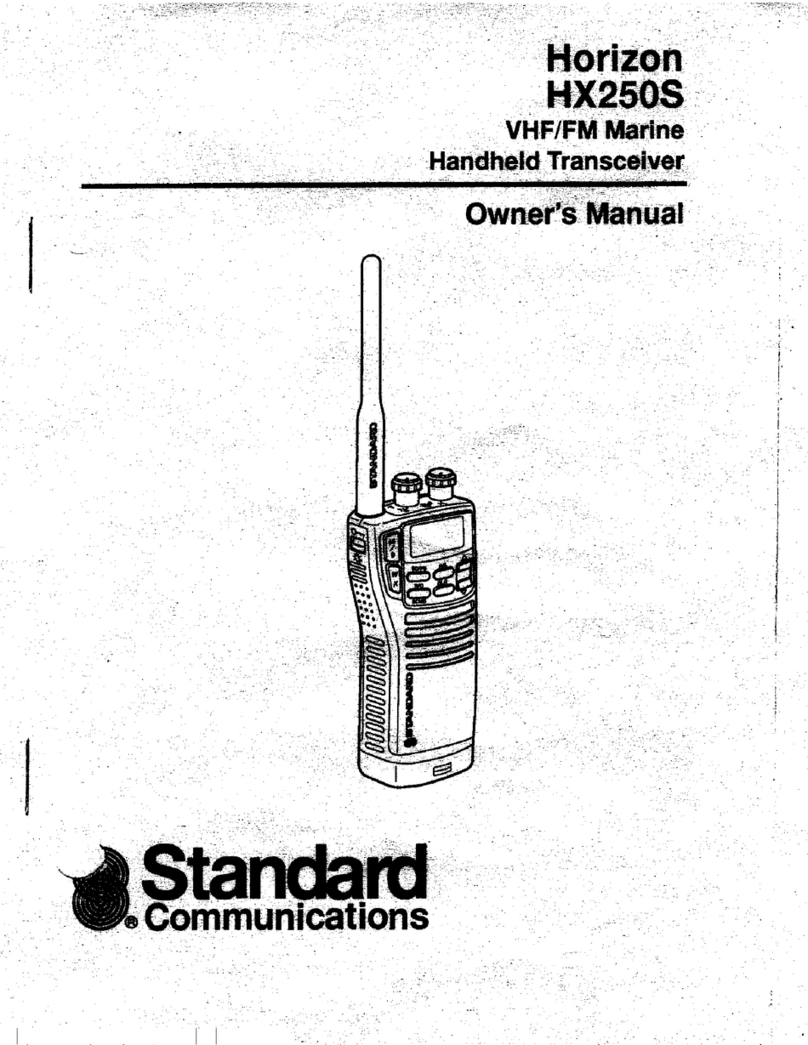
7
1. Circuit Configuration by
Frequency
The receiver is a double-conversion superheterodyne
with a first intermediate frequency (IF) of 67.65 MHz and
a second IF of 450 kHz. Incoming signal from the antenna
is mixed with the local signal from the VCO/PLL to pro-
duce the first IF of 67.65 MHz.
This is then mixed with the 67.2MHz second local oscilla-
tor output to produce the 450 kHz second IF. This is de-
tected to give the demodulated signal.
The transmit signal frequency is generated by the PLL
VCO, and modulated by the signal from the microphone.
It is then amplified and sent to the antenna.
2. Receiver System
2-1. FRONT-END RF AMPLIFIER
Incoming RF signal from the antenna is delivered to the
Main Unit and passes through Low-pass filter, antenna
switching diode D1004 (RLS135), high-pass filter and re-
moved undesired frequencies by varactor diode (tuned
band-pass filter) D1012 and D1013 (both 1SV325).
The radio signal is supplied to the RF amplifier Q1025
(2SC5006) amplified, applied to a tuned band pass filter.
The signal is then applied to the first mixer.
2-2. FIRST MIXER
The 1st mixer consists of the Q1036 (3SK293). Buffered
output from the RX VCO Q1040 (2SK508) is amplified by
Q1038 (2SC5005) to provide a pure first local signal be-
tween 223.675 and 229.650 MHz (Marine Band) or 201.650
and 241.650 MHz (LMR Band) for injection to the first
mixer.
The IF signal then passes through monolithic crystal fil-
ter XF1001 (±7.5 kHz BW) to strip away all but the de-
sired signal.
2-3. IF AMPLIFIER
The first IF signal is amplified by Q1041 (2SC4215Y). The
amplified first IF signal is applied to FM IF subsystem IC
Q1046 (BA4116FV) which contains the second mixer, sec-
ond local oscillator, limiter amplifier, noise amplifier, and
RSSI amplifier.
The signal from reference oscillator X1003 is applied to
FM IF subsystem IC Q1046 (BA4116FV) which increase
the frequency by 4 times, mixes with the First IF signal to
become the Second IF 450kHz.
The second IF then passes through the ceramic filter
CF1001 (LTM450GW for Wide band) or CF1002
(LTM450FW for Narrow band) to strip away unwanted
mixer products, and is applied to the limiter amplifier in
Q1046 (BA4116FV), which removes amplitude variations
in the 450 kHz IF, before detection of the speech by the
ceramic discriminator CD1001 (JTBM450CX24).
2-4. AUDIO AMPLIFIER
Detected signal from Q1046 (BA4116FV) is applied to De-
Emphasis circuit Q1009-3/-4 (LM2902PW). The signal
which appeared from Q1009 (LM2902PW) is fed through
the AF mute switch Q1045 (TC7S66FU) and the buffer
amplifier Q1009-1 (LM2902PW) to the AF volume
(VR1001). The audio signal is applied to audio amplifier
Q1005 (TDA2822L). The output signal from Q1005
(TDA2822L) is in audio speaker.
2-5. SQUELCH CIRCUIT
The squelch circuit is composed of a noise amplifier, band-
pass filter, and noise detector within Q1046 (BA4116FV)
and level shifter Q1032 (M62364FP-CH2). When a carrier
isn’t received, the noise at the output of the detector stage
in Q1046 (BA4116FV) is amplified by the level shifter
Q1032 (M62364FP-CH2). The amplified noise is applied
to the band-pass filter section in Q1046 (BA4116FV), then
detected to DC voltage by the detector stage in Q1046
(BA4116FV). The DC voltage is inputted to 98-pin (NOISE
port) of the CPU Q1035 (R5F2L3ACANFP).
When a carrier is received, the DC voltage at the 98-pin of
the CPU Q1035 (R5F2L3ACANFP) becomes “low” level,
because the noise is compressed.
When the detected voltage at the 98-pin of the CPU Q1035
(R5F2L3ACANFP) is “high” level, the 17-pin (AF MUTE)
of the CPU Q1035 (R5F2L3ACANFP) becomes “low” lev-
el. As a result, turns the AF mute switch Q1045
(TC7S66FU) to “OFF” to disable the audio output.
3. Transmitter System
3-1. MIC AMPLIFIER
The AF signal from internal microphone MC1001 or ex-
ternal microphone connected to J1002 (MIC/SP jack) is
amplified with microphone amplifier Q1017-3
(NJM12902V).
This signal is applied to the high pass filter Q1054-1
(LM2904PW) and buffer amplifier Q1020-4 (LM2902PW).
Afterwards, the AF signal is adjusted by the D/A con-
verter Q1032 (M62364FP-CH1). The adjusted AF signal is
applied to the splatter filter Q1017-4 (NJM12902V), Low-
pass filter Q1017-1/-2 (NJM12902V), and buffer amplifier
Q1020-2 (LM2902PW), the mic audio is applied to the D/A
converter Q1032 (M62364FP-CH4) which adjusts the
audio for Max deviation for normal or narrow band op-
eration. The mic audio is then applied to varactor diode
D1031 (HVC383B) that modulates the VCO transmit sig-
nal.
Circuit Description


































